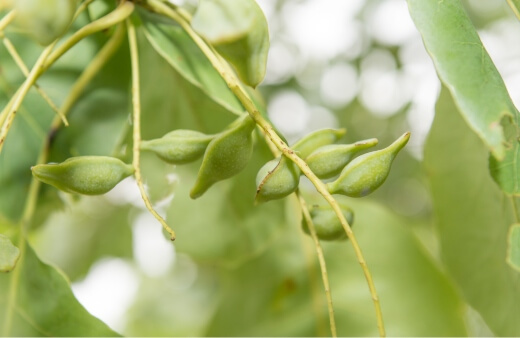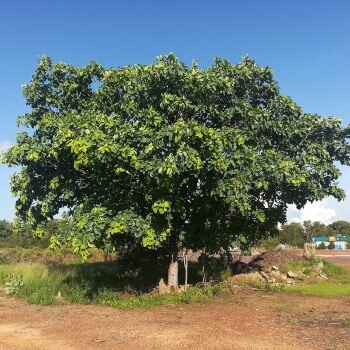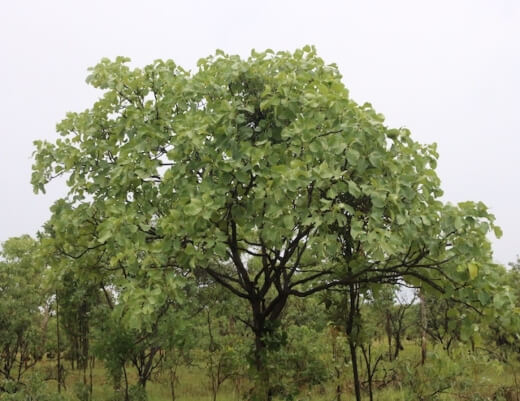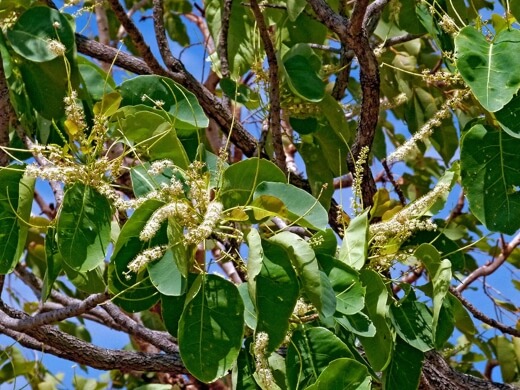One of our most ornamental and nutritious bush tucker-fruiting plants is the tropical Kakadu plum flowering tree. This plant’s plum-like fruits have been used as traditional bush food for centuries with global demand for these nutritious fruits now being at an all-time high.
The slender small to medium-sized tree sports a creamy-grey flaky bark, large broadly ovate pale-green leaves and spikes of creamy-white perfumed flowers at the ends of branches.
Here is how you can grow and care for this beloved bush tucker in your garden.
More...

Family: | Combretaceae |
|---|---|
Genus: | Terminalia |
Species: | T. ferdinandiana |
Common Names: | Kakadu plum, billygoat plum, gubinge, green plum |
Location: | Outdoor |
Type: | Tree |
Growth: | 6 to 10 metres tall, 3 to 5 metres wide |
Sun requirements: | Full sun |
Foliage Colour: | Green |
Flower Colour: | Cream |
Flowering: | Spring to summer |
Fruit: | Edible yellow-green fruits in late summer |
Maintenance level: | Low |
Poisonous for pets: | Non-toxic to cats and dogs |
Introducing the Kakadu Plum Tree
Often labelled as the Northern Territory and Western Australian “superfood”, these healthful yellow-green fruits offer food enthusiasts many culinary applications in their kitchens at home.
Other than its fruits, this bushland tree sports attractive foliage and flowers that can boost the native appeal of any garden, regardless of the setting.
Whether you’re looking for an accent tree for the garden or you’re a fan of consuming native fruits, this tree certainly has it all.
Scientifically labelled Terminalia ferdinandiana, the tree’s common names now include Kakadu plum, billygoat plum, gubinge and green plum. The name was inspired by the first European botanist to describe Kakadu plum, Ferdinand Mueller.
Natively, the tree is widely distributed throughout the subtropical and tropical woodlands from north-western Australia to the eastern regions.
Forming a part of the Combretaceae family, the tree naturally thrives in more topical climates and it has a deciduous lifespan so it will lose its leaves in the dry seasons.
Terminalia ferdinandiana Growing Habits
Within gardens, the tree will grow to around 6 to 10 metres tall and 3 to 5 metres wide but could reach larger heights if grown in particularly good conditions.
Considered to have a medium growth rate, these trees do grow quite wide as they mature so placement in landscapes needs to be carefully considered.
This plant is waterwise and it self-pollinates meaning you only need one tree to enjoy its luscious influence and edible nutritious fruits though, establishing more than one is always an option if you have the space.
The tree can take up to 5 years or more to fruit and flower if established from seed or seedlings. Common landscaping applications include:
- Screening
- Accent/Feature
- Filling in and around lawns
- Shade tree
- Fruit-bearing tree
How to Grow Kakadu Plum in Australia

Source: outbackjoe.com


Get Your Free Guide:
Master Growing Australian Natives eBook
A Must Have Complete Guide for Every Australian Garden
Get Your Free Guide:
Master Growing Australian Natives eBook
A Must Have Complete Guide for Every Australian Garden
Most growers choose to establish these plants from seedlings or young trees purchased from reputable nurseries. Here is our list of Australian nurseries you might want to look into.
Seedlings and young trees will strike far sooner in your garden meaning they will flower and fruit a lot faster than trees grown from seed. If you wish to grow your Kakadu plum tree from seed, here’s how you can do it.
Growing Billygoat Plum from Seed
- Once the fruits have ripened and softened, collect a couple to extract the seeds from. Each fruit should contain one seed.
- Gently remove the flesh from around the seeds then soak them in warm water overnight to soften the seed coats.
- Prepare seed trays or small containers filled with an organic seed-raising mix or a potting mix.
- Gently sow the seeds just under the surface, about 1 cm deep.
- Water lightly after sowing then place the seeds in a warm location in full sun.
- Keep them moist and warm until germination, which should occur within 3 months.
- Allow seedlings to develop further before transplanting them into the garden.
Ideal Conditions for Planting Kakadu Plum
Being a tropical plant, this tree is best grown in warmer climates with minimal frost. As with most fruiting plants, lighting will be an essential component to the overall health and abundance of blooms and fruits.
Planting should be done in spring to early summer during the plant's active growing season. If you are planting more than one tree, be sure to plant them far apart as the wide canopies may interfere with one another someday.

Source: olelantanaseeds.com.au
Here are the preferred growing conditions for gubinge:
Gubinge Sunlight Needs
The tree will thrive in full sun positions within landscapes. It needs to experience 80 to 100 percent of the day's sun to grow and produce optimally.
Be sure to also plant it away from other large plants or trees as surrounding vegetation shouldn’t hinder its daily sun exposure.
Soil Requirements
This plant is pretty tolerant to many soil types but prefers sandy, peaty or sandy-clay soils with good drainage and a neutral pH balance. To give your soil a little boost, consider mixing in some organic compost before planting then repeat annually in spring.
To test your soil’s pH level, check out our review of the best moisture meters available online.
Temperature & Humidity
General garden humidity should be perfect provided you live in a warm climate. If you’re worried about humidity, you can always plant a few smaller species around the tree to naturally increase the humidity of the area.
Alternatively, you can occasionally add some organic mulch around the base of the tree in summer to help with moisture retention.
How to Care for Kakadu Plum Tree
Caring for these trees can be made simple as long as you find the right balance of sun and water. These factors can vary depending on your conditions so you’ll need to closely monitor your tree during its early development to see what it prefers in your garden.

Source: territorynativeplants.com.au
Water Needs for Green Plum
Generally, moderate waterings are required but the frequency can be varied depending on your conditions. In hotter climates with little rainfall, the tree will need to be watered a lot more than trees grown in cooler climates with more natural rainfall.
A good starting point is to water every 10 days or so and monitor and adjust from there.
Pruning for Prolific Growth
You will need to prune regularly to ensure your tree thrives and to discourage disease. Prune in early spring to remove any unhealthy, broken or dead branches. Once pruned, your tree should be ready for its active season.
Click here for more tips on pruning different types of Australian native plants.
Fertilising Gubinge
Though not needed for prolific fruiting and flowering, some trees may need an extra boost in cooler climates. Be sure to always use an organic fertiliser or native blend when feeding bush tuckers.
Click here to see our review of the best organic fertilisers for 2024.
Fertilise in spring at half the recommended dosage. Slow-release granular fertilisers can also work great as long as they are organic.
Kakadu Plum Bush Tucker Guide

Source: foodnavigator.com
The small egg-shaped pale-green fruits are a notorious bush food. At home, they can be used in many ways and offer many health benefits. Once matured, these trees will produce abundant crops of fruits which can be enjoyed fresh or stored for consumption at a later stage.
Not only do the fruits offer us many nutritious properties but they are also great for your skin, now being used in many beauty and cosmetic products as well.
The fruits are also a major food source for many important small mammals like possums, rock and tree rats and bandicoots. The plum-like fruits are especially high in vitamin C, containing 50 times more than oranges.
Here are some of the other useful nutritional benefits of consuming Kakadu plums:
- They contain many important antioxidants
- They contain folic acid and iron
- Their vitamin C content is among the highest of any natural source
- Each fruit contains only 59 calories making them the perfect snack for those who are monitoring their caloric intake.
- The fruits can help naturally reduce headaches and other mild skin conditions
How to Use Kakadu Plums
Traditionally, the fruits were used as a bush tucker for traditional medicines for centuries and the inside bark was used to treat various skin ailments and other infections.
The high oxalic acid content in the fruits can make them slightly toxic to certain individuals when consumed in large quantities so, as with most native fruits, moderation is important.
The ripe fruits can be enjoyed raw or used as a fruit-based addition to gourmet bush condiments like jams, chutneys, pickles, sauces, relishes, juices and even added to ice cream.
The fruits have a slightly bland taste with definite sour and salty notes. Their consistency is fibrous and the flesh and skin are used for consumption.
The taste and texture often lead growers to rather use the fruits in condiments or as part of dishes like stir-fries and stews. They also make for excellent additions to baked goods.

Source: mayiharvests.com.au
Harvesting Kakadu Plum Fruits
- Fruits will form towards the end of the tropical summer between March and May
- When ripe, the fruits will soften to the touch and start deepening in colour
- To harvest, simply pluck the ripe fruits from the branches of your tree and rinse them before use or storage
How to Store Green Plums
If you decide not to enjoy the fruits fresh during the harvesting season, you can freeze the fruits for use throughout the year. Be sure to rinse the fruits and freeze them within 24 hours of harvesting. You can optionally remove the seeds before storage as well so you can quickly add frozen plums to your desired dishes or juices.
Alternatively, the plums can also be dehydrated or canned as a preservative. For those looking to experiment with Kakadu plums in the kitchen, check out this brownie with Kakadu plum powder for a delicious twist on a classic dessert.
Possible Kakadu Plum Pests & Diseases
Kakadu plum trees rarely suffer from any pest or disease issues. Being so well-adjusted to our endemic conditions, they seldomly give growers hassle, especially when established in caring gardens.
The fruits may attract small insects and mammals so netting your tree (see this netting mesh bag for reference) is an excellent way to deter these guys. Alternatively, be sure to always remove ripe fruits and pick up any dropped and fermenting fruits from around the tree.
If smaller pests like aphids or scale insects become an issue, treat your tree with an organic insecticide or a quality neem oil and it should bounce back in no time.
Kakadu Plum Frequently Asked Questions

Source: territorynativeplants.com.au
What is Kakadu plum good for?
Traditionally, the fruits were used as a medicine to treat colds, cases of flu and headaches. They were also used as an antiseptic and soothing balm for limbs and muscles. Nowadays, fruits are prized for their high nutritional value when consumed.
Why is Kakadu plum good for the skin?
The very high vitamin C content is an important ingredient in many skin care products like creams, masks and lotions. Some say using these products can make your skin glow more naturally. The antioxidants also protect your skin from harmful free radicals.
Is Kakadu Plum a superfood?
The fruits are considered some of Australia’s top superfoods for their exceptional nutritional and antiseptic properties. The fruits have been a very important food and medicine in Northern Australia for millennia.
How long does a Kakadu plum tree live?
Usually, these trees will live for about 10 to 25 years depending on the growing conditions and care given.
Here are some other amazing popular bush tuckers to consider establishing alongside your Kakadu plum as well as how to grow and care for them:
Kickstart Your Native Gardening Dreams with the Nutritious Kakadu Plum Tree
Whether established for its attractive bark, prolific creamy blooms and large oval leaves or the tree’s fantastic bush tucker properties, it will certainly impress as a feature that can provide abundant fruits that are an excellent nutritious addition to your family’s favourite dishes.
Native or more orthodox garden settings can suit this tree perfectly and its lively presence in gardens is hard to beat thanks to its famed fruits and flowers. If you’re a bushfood enthusiast, look no further than the Kakadu plum tree.
Published on September 3, 2022 by Nathan Schwartz
Last Updated on January 26, 2025





It would be good to know where to buy on line some kakadu plum seeds. I did not succeed to find it out. I am Italian and I love very much tropical plants.
Thank so much dear Nathan
Hey Giancarlo,
Thanks for reaching out, we are currently working on being able to provide seeds and plants through our website.
For the Kakadu plum seeds here are 2 sites where they can be purchased (just incase one becomes out of stock).
https://herbalistics.com.au/product/terminalia-ferdinandiana-kakadu-plum-seed/
https://www.olelantanaseeds.com.au/product/terminalia-ferdinandiana-billygoat-or-kakadu-plum-seeds-x-3/
Be sure to let us know of where you purchase your seeds and the success rate of growing your plants.
All the best,
Nathan
Hey, i got a few trees growing in the Kimberley’s of W.A. and flowering + fruiting now, with a good crop of fruit on’m right now. Anyone wanting a few seeds feel free 2 contact us 4 some, happy to help out other green fingered people, if i can ?
Hey Derbyiter,
Thanks so much for your offer, I am sure a few people will hit you up for some seeds.
Best regards,
Nathan Schwartz